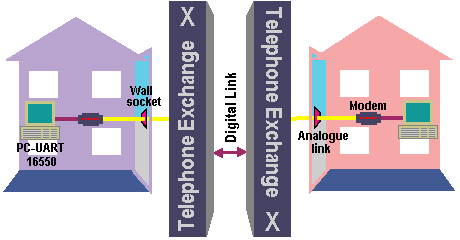A modem allows a PC to connect to other computers and enables it to send and receive files of data over the telephone network. At one end it converts digital data into a series of analogue signals for transmission over telephone lines, at the other it does the opposite, converting an analogue signal into digital data.

Modems come in two types, internal, fitting into an expansion slot inside the PC’s system case or external, connected to the PC via one of its serial ports (COM1 or COM2).
Early modems were asynchronous devices, operating at slow rates of up to 18000bit/s in FSK modulation, using two frequencies for transmission and another two for receiving. Asynchronous data is not accompanied by any clock, and the transmitting and receiving modems know only the nominal data rate. To prevent slipping of the data relative to the modems’ clocks, this data is always grouped in very short blocks (characters) with framing bits (start and stop bits). The most common code used for this is the seven-bit ASCII code with even parity.
Synchronous modems operate at rates up to 56 Kbit/s in audio lines, using synchronous data. Synchronous data is accompanied by a clock signal and is almost always grouped in blocks. It is the responsibility of the data source to assemble those blocks with framing codes and any extra bits needed for error detecting and/or correcting according to one of many different protocols (BISYNC, SDLC, HDLC, etc.). The data source and destination expect the modem to be transparent to this type of data, conversely, the modem can ignore the blocking of the data. The usual modulation methods are the phase modulation and integrated phase and amplitude.